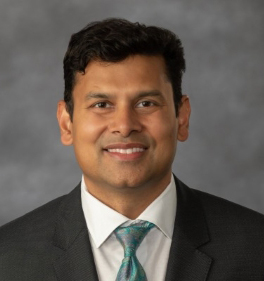Join the UC Davis Health team that provides patient care at home | UCnet

By Stephanie Buck, UC Davis Health
When he was a boy, Dr. Vimal Mishra contacted his doctor grandfather for calls near where they lived in India. He has fond memories of his grandfather providing meticulous care in a well-equipped, comfortable environment for each patient.
This early vision of patient-centered care greatly influenced Mishra, shaping his vision for the future of healthcare. Now an intensive care physician himself and chief medical officer, Mishra wishes it were that easy.
He said: “That was the best kind of care I’ve seen for the family and the patient, but he could see maybe one or two patients at the end of the day. «It’s impossible.»
The health care industry has been transformed by building hospitals and clinics, organizing care and resources around physical locations. It then asked patients to visit providers for their care, rather than the other way around. It was an imperfect solution.
We are now at a critical time in history where technology is enabling a return to home care, while improving internal processes to free up providers’ time.
«We can provide the same equipment around patients. We are breaking that brick and mortar system,» said Mishra.
His team at UC Davis Health is at the forefront of it. They call it Connected Care Center.

Joint Chief Medical Officer Vimal Mishra, MD, believes in the importance of patient-centered care that reaches patients where they are.
What is Connected Care Center?
The Connected Care Center (CCC) is a team and technology that helps deliver patient-centric care at the right time and in the right place. The goal is to use technology to care for patients where they are.
CCC has five programs:
- Express Care: Quick video meetings with vendors
- ED to Home: Caregiving at home after a specific ER visit
- Urgent Home Care: Home care visits for urgent medical problems
- Post Discharge Bridge Clinic: Care of high-risk patients from hospital to home
- Remote Patient Monitoring: Medical tools to monitor and coordinate with other patients from home
Conceived by Mishra and Senior Director of Ambulatory Operations BJ Lagunday, CCC aims to «improve the way we deliver care, making it easier and more accessible to everyone,» said Lagunday.
How does it work?
A patient’s journey with the CCC team begins when the provider sends them. Let’s say a patient suffers from chronic hypertension but refuses to return to the ER during the next crisis. A nurse or doctor can refer them to a new CCC monitoring program. After installing a home blood pressure monitor, the patient’s readings will be immediately sent to the CCC care team and simultaneously entered into their medical charts.
«They have access to us and we have access to them,» said Crystal Hapgood, CCC nurse manager. «This is the digital face of the program that allows us to access real-time support.»
After a month or two of life observation, education and support from providers, the patient should be ready to return to the general practitioner and clinic, armed with tools and knowledge.
Importantly, the work process is invisible to the patient. CCC is an internal program that coordinates a seamless patient experience between different care systems, ensuring that no one falls through the cracks.
Join the group

Medical Assistant Mai Xiong and Patient Services Representative Yadira Rosas in the Health Care Services building.
Unlike a brick and mortar clinic, CCC is not a fixed location. It has a diverse team of clinical providers and support staff, including physicians, nurses, medical assistants, pharmacists, practice managers, nurse managers and patient service representatives.
The team relies on strong relationships with nurses across the system. Any nurse or doctor at UC Davis Health can refer patients to CCC. About 80% of CCC patient referrals come from the nursing triage line, e.g.
Finally, the right technology plays its important role. The CCC model is based on digitally enabled care in the form of advanced tools, remote clinical diagnostics, mobile clinics and more, all seamlessly integrated into existing EMR workflows.
Why is it important to patients and UC Davis Health?
The Connected Care Center program aims to improve traditional health care delivery by providing more patient-centered care at home, making it more accessible and efficient for patients and providers alike.
Its first program, Express Care, was conceived during the COVID-19 pandemic as a way to expand primary care. By offering patients real-time video visits, UC Davis Health transferred fewer patients to urgent outpatient care.
«This way, the patient’s chart information is always in our system, so the primary care physician is up to date,» said Chief Operating Officer Tom Nguyen.
The example looks simple:
- Since starting Urgent Care at Home, CCC has reduced unnecessary visits to the ED. Of the 815 patients they treated between September 2023 and February 2024, 77% said they would have gone to the ED if not for home services.
- Express Care alone saw 24,000 patients last year and is on track to match that figure this financial year, with an average of 75 patients a day.
Patients enjoy receiving care at home. Whether it’s through a video conference, a remote blood pressure test or a home visit from urgent care, patient testimonials for UC Davis Health have been overwhelmingly positive, according to a Net Promoter Score survey.
And while technology plays an important role in the future of health care, it will never replace primary care clinics or hospitals, especially providers who build relationships with their patients. Just like Mishra’s grandfather did.
«Because in the end that’s what heals you,» said Mishra.
#Join #Davis #Health #team #patient #care #home #UCnet